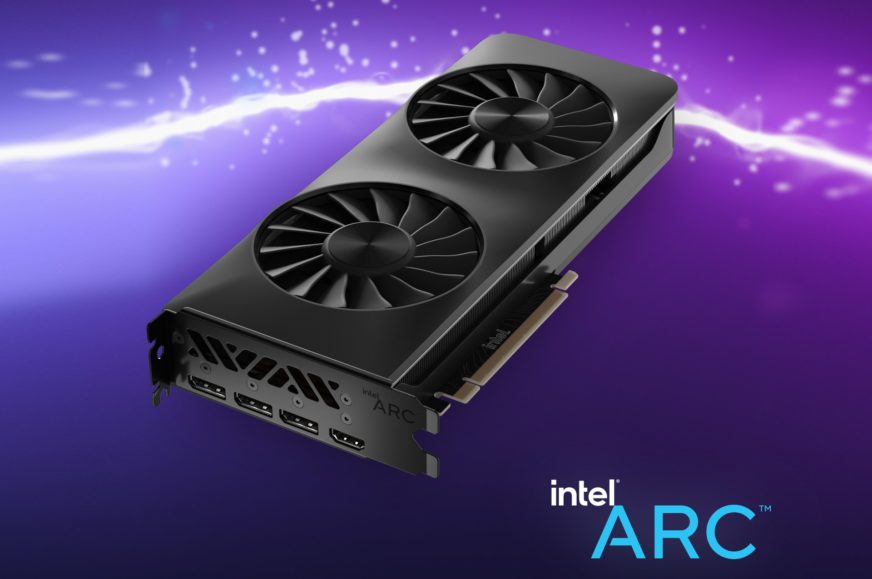Intel Arc gaming graphics cards with ACM-G10 GPU unveiled: the specifications
The coming of Intel Arc discrete graphics cards was strange – the company tried to keep up the audience excited with constant stream of news, but the efforts were thwarted by the long delays. But the long and slow, gradual trickle of all sorts of news bits is almost over. Finally, Intel has unveiled the gaming graphics cards with their most powerful GPU yet, up to 16 GB of memory and 4096 shaders. So now we’ll see what’s what.
For desktops, Intel has so far only released the Arc A380 graphics, which we covered before in this article. That was the model based on the ACM-G11, the slower of the two 6nm GPUs of the Alchemist generation. It has 1024 shaders and a 96-bit memory bus and is thus in the weight category of AMD Navi 24 (against which, however, it is much larger, admittedly with some extra functionality such as AV1 decoding and also encoding). But alongside that, Intel has an even bigger ACM-G10 chip with 4096 shaders and a 256-bit bus, which naturally has quite a bit better gaming potential – and cards based on it have been revealed now.
Arc A580
The first model that has the ACM-G10 in it is a card of the slightly less powerful “Arc 5” class (these branding is basically structured like the Core i3, i5, i7 scheme that CPUs use), labelled Arc A580. This card might actually be a kind of pleasant surprise. It was originally expected to have a bland configuration where only half of the chip would be active. But in the end, Intel may have pushed this and the following model a little higher (if the previous leaks were true and not wrong). In the end, Arc A580 has the GPU trimmed down to still capable 3072 shaders (24 Xe Cores). This also means 24 RTUs (ray tracing acceleration units) and 384 XMX units (AI accelerators).
The GPU will have a slightly lower clock speed compared to other Arcs, which typically run at 2 GHz or above. Intel lists a clock speed of only 1700 MHz (admittedly, this is probably the base frequency, not boost), but that can be increased for non-reference OC cards. Or from another perspective, there could be good potential for overclocking.
This is more so because the card doesn’t have its memory bus trimmed, which was something pretty much expected from this model (originally we thought that the memory would be cut to 128 bits). The GPU has a full 256-bit bus (maybe also a full 16 MB L2 cache) and 16.0 GHz GDDR6 memory in 8 GB capacity. These specs give a bandwidth of 512 GB/s.
Intel has not yet disclosed the TDP of this graphics card, but it could probably be between 150–200 W.
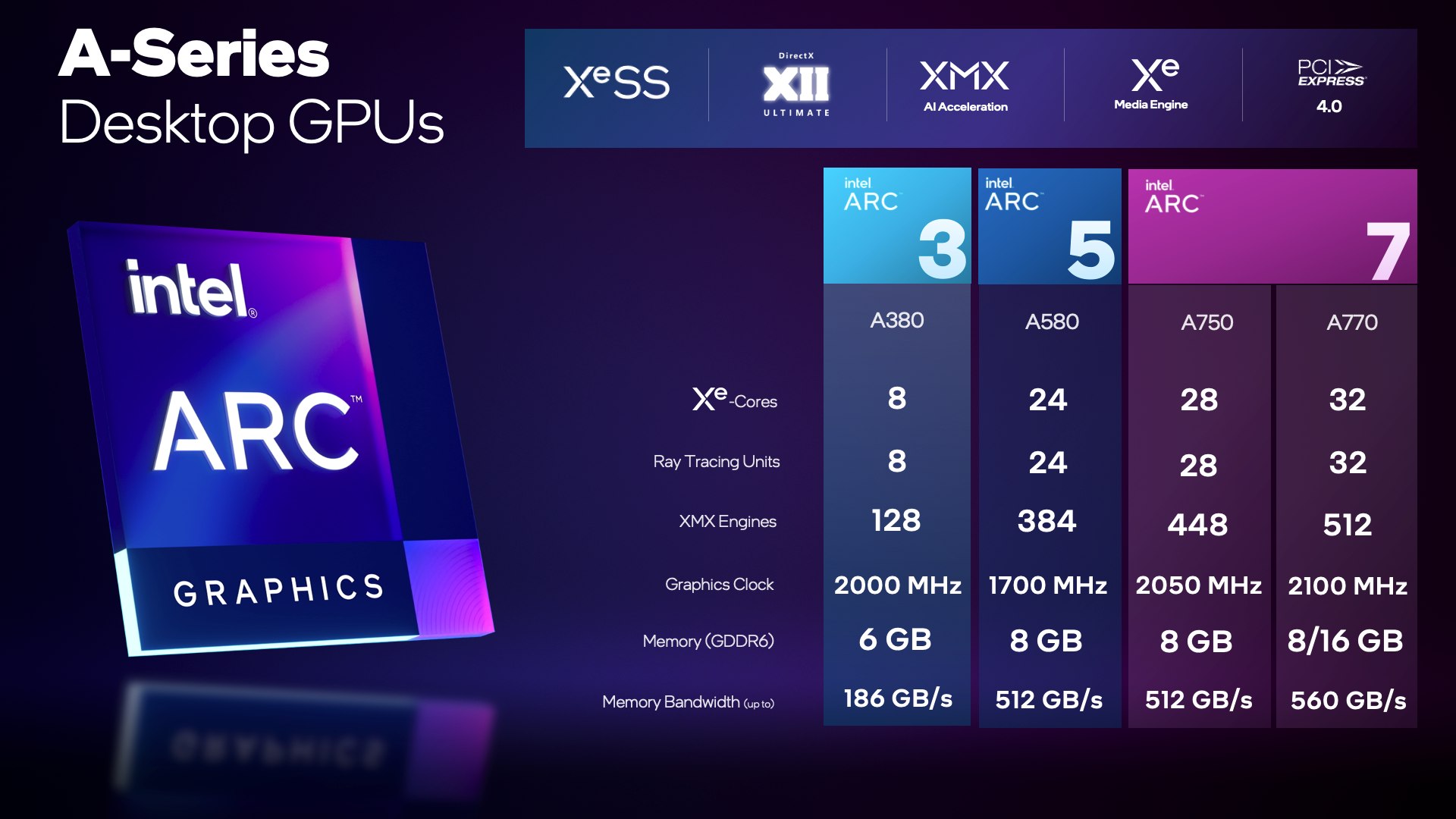
Arc A750
Also the second model, now from the higher category “Arc 7”, has evolved and comes with a bit better specifications than originally hoped. This card was initially expected to be the 75 % cut of the die (with 3072 shaders, 192-bit bus). But in fact it has 28 Xe Cores, or 3584 shaders, 448 XMX units, and 28 RTUs. The base clock is higher too at 2050 MHz, so the jump from the previous model should be a bit more than what you’d expect just by the number of units.
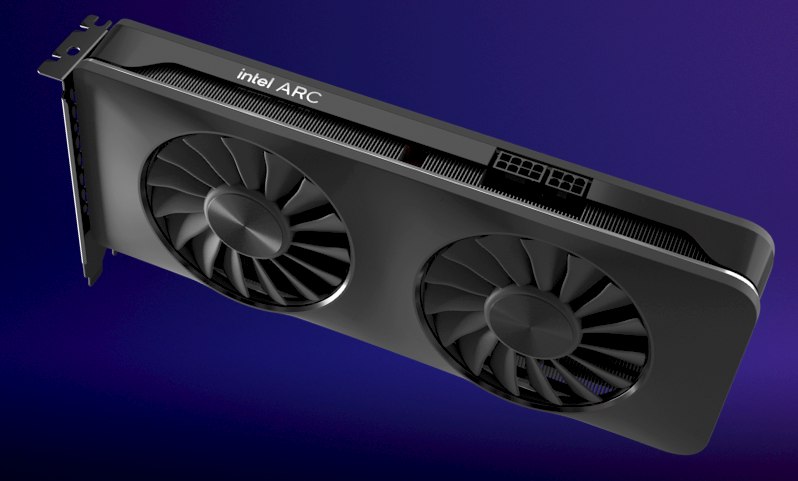
On the other hand, the memory subsystem is the same, with a full 256-bit bus and on it 8 GB of GDDR6 memory at a clock speed of 16.0 GHz effectively. This in turn delivers a bandwidth of 512 GB/s. In this case, we do know the TDP for this graphics card: 225 W. The power supply will be one eight-pin and one six-pin connector.

Arc A770
The top model is the Arc A770 card. It has a full version of the chip with 32 Xe Cores (4096 shaders, 32 RTUs, 512 XMX), running officially at the base clock of 2100 MHz. However, the TDP is the same 225 W, so it’s a question whether the card won’t see a relatively smaller performance gap from the cheaper Arc A750 model discussed before.
On the other hand, this SKU will have an advantage in memory. In fact, its GDDR6 will run at up to 17.5 GHz effectively, giving a bandwidth of 560 GB/s. Capacity will be 16 GB (this was the originally expected configuration), but there will also be a cheaper 8 GB version as an alternative. This is probably because although this is the highest end model for Intel, it will compete with only lower to mid-range mainstream graphics cards of Nvidia and AMD. Therefore, it will have to offer an attractive price – which will probably be mainly the case for the cheaper 8 GB version. The 8GB cards are likely to be most of the ones on offer, with 16 GB cards likely to be in the minority.
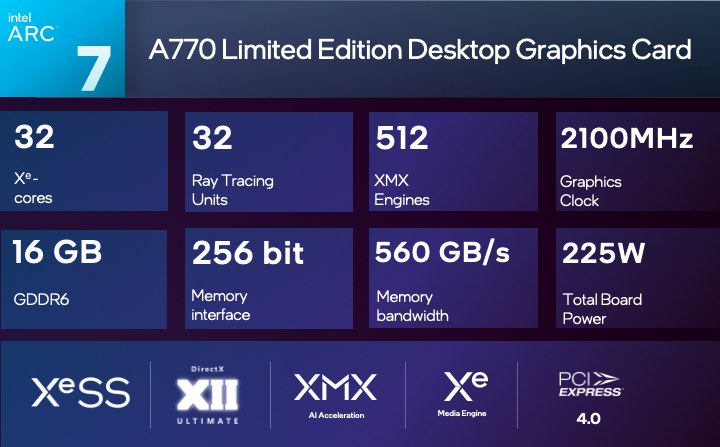
The configuration of these three models makes it look a bit like Intel’s GPU division under Raja Koduri is following AMD’s recipe from the days of the Radeon R9 290 and 290X (or R9 Fury and R9 Fury X), where the second model in the ladder had a performance only slightly lower against the top model. There may have been a reason for this then (and now), though – the competition was faster then and AMD has been under pressure (as Intel is now). Since it’s probably not possible to push the performance much further with the top model, the company tries to prop up at least the second card in its line-up, which therefore moves closer to the top SKU. In comparison, Nvidia seems to prefer the next lower model in the line-up to offer just around 70 % of the performance of the higher model.
According to Intel, the Arc A770 is supposed to have better performance than the Nvidia GeForce RTX 3060 including games with ray tracing, where Intel’s Alchemist architecture is said to have similarly good performance to Nvidia’s Ampere architecture. In a competitive comparison with AMD, the A770 is said to outperform the Radeon RX 6600 XT (and we assume in ray tracing, the gap would be even more significant?). Intel does not mention GeForce RTX 3060 Ti and Radeon RX 6650 XT models, which probably means those cards are already coming on top of this model of Intel’s first Arc GPU generation (again with the possible exception of ray tracing for the Radeon, if Intel’s words that its architecture is better at these effects are confirmed).
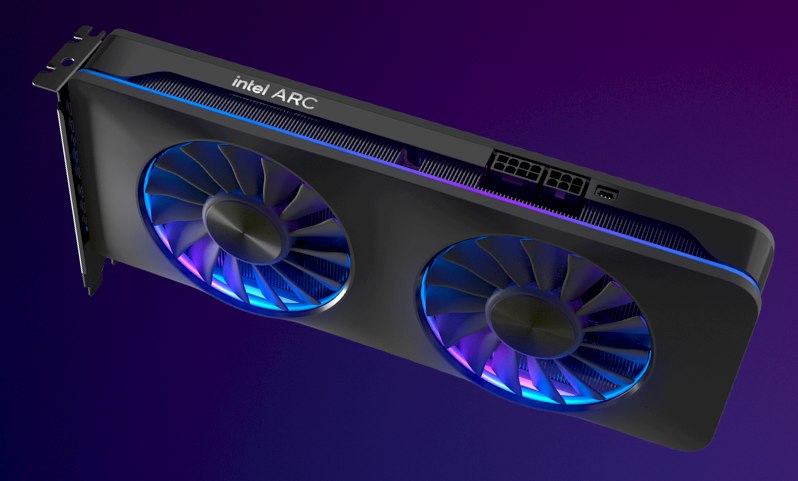
PCI ReBAR a must, Limited Editions, DisplayPort 2.0
These graphics should share the multimedia features of the Arc A380 card, which means there is for example a hardware encoder for the AV1 video format (in addition to the decoder). Like the smaller GPU, the ACM-G10 has two multimedia engines. For all cards, the GPU uses PCI Express 4.0 ×16 for system connectivity, and the GPU supports four outputs (DisplayPort 2.0 and HDMI 2.0; HDMI 2.1 with resolutions higher than 4K is only possible when an additional converter from DP 2.0 is added by the manufacturer).
On the other hand, there is also one negative “feature” to mention – Alchemist GPUs are extremely dependent on support for PCI Express Resizable BAR (Smart Access Memory on the AMD platform). These GPUs can’t handle small memory accesses well and require “ReBAR” to achieve good performance – and we aren’t talking small differences here, there is a truly massive degradation without it. This is apparently a trait of the architecture that is not expected to be resolved in some future driver update. Even Intel has communicated that this generation of Arc graphics is not really suitable for users whose CPU and motherboard do not support ReBAR (or Smart Access Memory, which works the same way).
Read more: Intel stopped supporting DirectX 9 games in Arc graphics drivers, they run through emulation
The cards will exist in non-reference versions, with cooling designs of the card manufacturers (who could include MSI and ASRock, who already make Arc A380 cards). The Arc A750 and A770 models will also be offered in reference version directly from Intel, which uses a cooler with two axial fans. You can see it in the illustrations of this article. So the status of these cards is similar to the “Founders Edition” cards from Nvidia, Intel is also supposed to sell these cards directly in their own online store.

The Limited Edition version could be an attractive option for the A770, as the limited cards directly from Intel are supposed to have 16 GB of memory. Most non-reference cards from partners, on the other hand, will reportedly be 8 GB. The question, however, is whether the price premium for that extra memory will be adequate.
The date of availability in stores and prices are not yet known. Hopefully soon
This reveal is only a paper launch for now, the cards have not gone into stores yet: the actual start of sales should probably happen quite soon, but no date has been revealed. Unfortunately, prices have also not been announced yet. As you may have noticed, Intel hasn’t fully disclosed the complete specifications (TDP) for the A580, which is expected to be released a bit later. Apparently, initially only the Arc A750 and Arc A770 will come out right on D-Day.
We expect that the company will try its best to make the release before Nvidia’s next-generation graphics arrive, because releasing after them would probably be another symbolic loss for Intel. However, Nvidia will do its own pre-reveal of the first models as early as Sept. 20 (availability probably won’t be until October). And Intel may not be able to beat that.
Software bundle worth hundreds of dollars
It’s probably almost certain that Intel will be lagging behind both competitors in sales, because in addition to performance, it doesn’t have a comparably developed ecosystem of services and technologies and game support in its drivers (and that counts even setting aside the fact that it has a weaker brand and can’t rely on inertia or customer loyalty). The company will try to overcome this with, among other things, an attractive software bundle offering that you’ll be able to get thrown-in with Arc 5 and Arc 7 graphics (so all three previously discussed models, but also the laptop versions).
This promotion will run until the end of the year (12/31) and has already been running on laptops since 8/25. Intel will give you Call of Duty: Modern Warfare II, Ghostbusters: Spirits Unleashed, Gotham Knights (which is three games total) and some bonus content for the free-to-play Vampire: The Masquerade – Bloodhunt game to go with your Arc card for free.
In addition, you can choose three of the five creative programs from the following list: PowerDirector 365, D5 Render, Magix Video Pro X14, Topaz Gigapixel AI and XSplit Premium Suite.
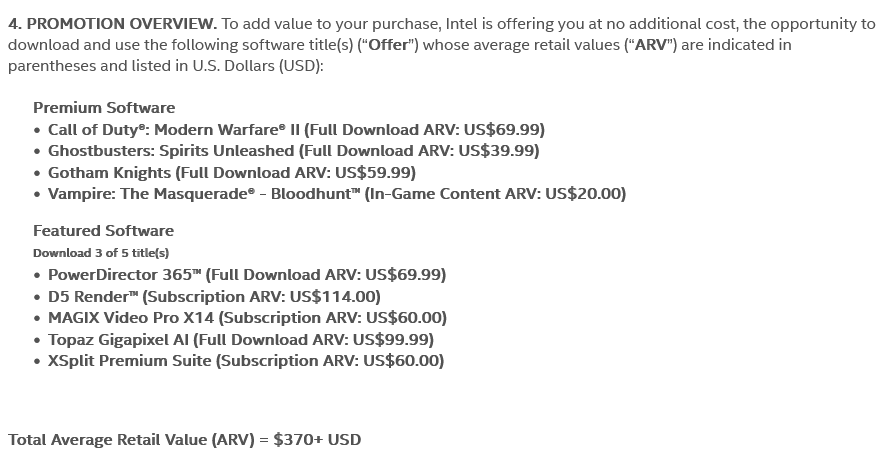
In total, the value of these licenses is supposed to be up to 370 USD if you had to buy everything by regular means at MSRPs. That’s quite possibly more than the value of the graphics themselves (but Intel will probably pay a lot less for these licenses). The catch, however, is that this offer is not valid when you buy the graphics cards themselves: an Alder Lake generation Intel processor must also be purchased at the same time – so it seems that this bundle will only apply to entire desktop rigs and laptops. Laptops in particular will probably be the most common beneficiaries of this bundle in practice. Well, as long as you’re inclined to give Intel a chance in a laptop. Which is not a trivial decission, you can’t usually replace a mobile GPU in the event of a bad experience, you are basically going to be together till death (of the computer) takes you apart.
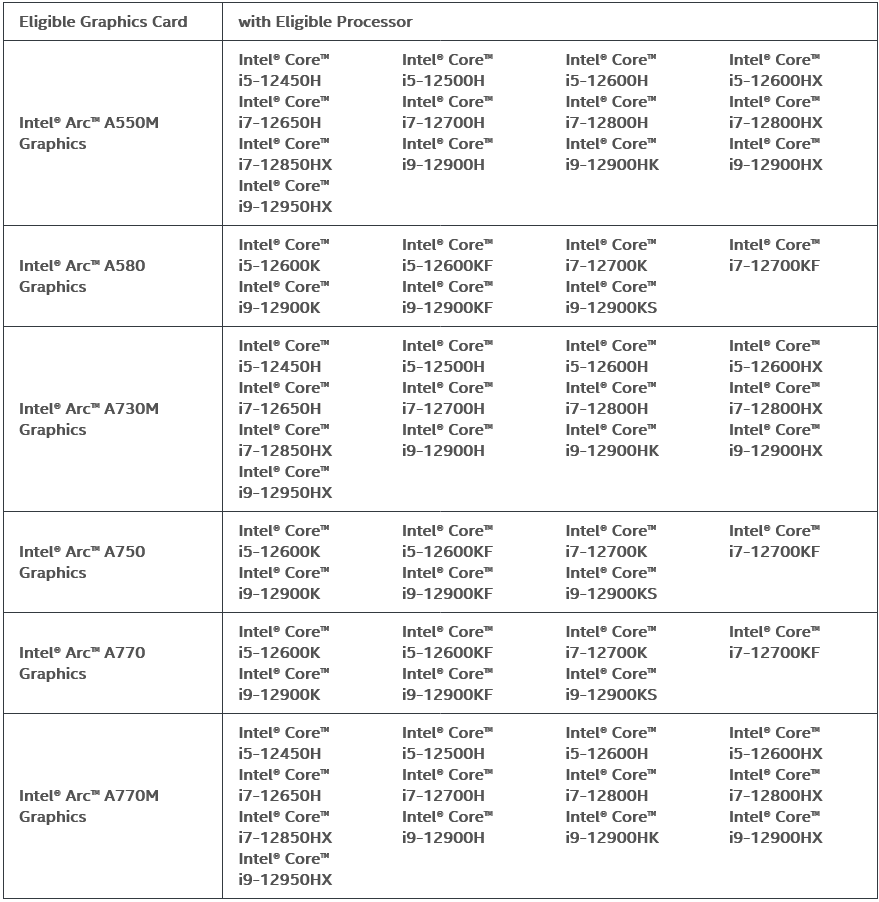
Sources: Intel (1, 2) VideoCardz (1, 2)
English translation and edit by Jozef Dudáš
⠀





